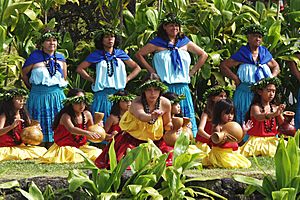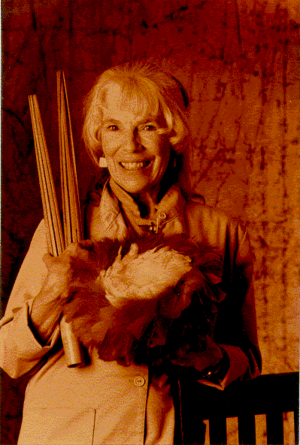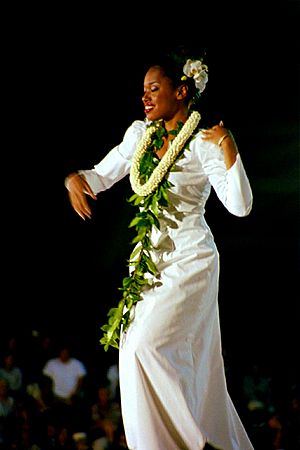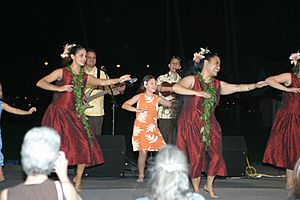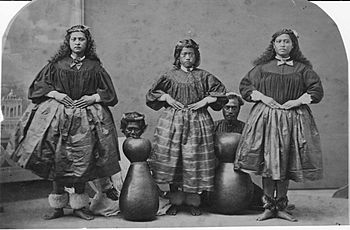Hula facts for kids
Hula is a special word from the Hawaiian islands. Both boys and girls can dance hula. Long ago, hula was only for important ceremonies. Today, hula is mostly for fun and entertainment.
Hula dancers often wear a grass or leaf skirt. They also wear a flower necklace, called a "lei" in Hawaiian. Sometimes, they put a flower in their hair.
Traditionally, hula dancers move to a chant. A chant is like a sung poem with a rhythm. The person chanting often beats their hand on a dried gourd (a type of squash) to make the rhythm.
There are different kinds of hula dance. For example, Hawaiian hula is usually slow and graceful. Tahitian hula, from another island, is often fast and lively.
Contents
Traditional Hula: Hula Kahiko
Hula kahiko is the old, traditional style of hula. It includes dances made before 1894. These dances do not use modern instruments like guitars. Hula kahiko can be serious and sacred, or light and fun. Many of these dances were created to honor important chiefs or to entertain them.
Today, hula kahiko is simply known as "Traditional Hula."
Many hula dances are seen as religious performances. They are dedicated to or honor a Hawaiian goddess or god. In the past, even a small mistake in these dances was thought to bring bad luck. Dancers learning sacred hula would often be kept separate and protected by the goddess Laka during their training. Special ceremonies marked when they had learned the dance well.
Today, hula kahiko is performed by dancing to ancient chants. These dances often use traditional costumes. They have a serious look and show deep respect for their spiritual roots.
Ancient Chants
Hawaiian history was passed down by speaking, not writing. Stories, family histories, and important events were put into chants. People memorized these chants and passed them from one generation to the next. This was how they kept their history accurate before they had a written language. Chants told stories about how the world was made, old myths, kings and queens, and other important people and events.
Hula Instruments
Hula kahiko uses special instruments to create its unique sounds:
- Ipu – A single drum made from a gourd.
- Ipu heke – A double gourd drum.
- Pahu – A drum covered with sharkskin, considered very sacred.
- Puniu – A small drum worn on the knee, made from a coconut shell with fish skin.
- ʻIliʻili – Smooth lava stones used like castanets.
- ʻUlīʻulī – Rattles made from gourds with feathers.
- Pūʻili – Split bamboo sticks that make a clacking sound.
- Kālaʻau – Rhythm sticks.
Sometimes, male dancers wore anklets made of dog's teeth. These also made sounds as their feet stamped, adding to the music.
Traditional Costumes
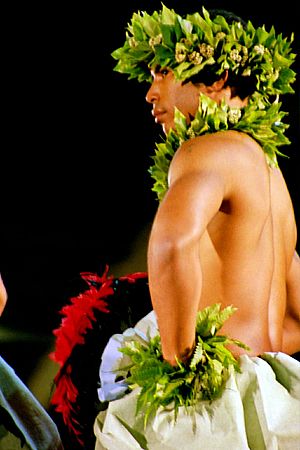
Traditional female dancers wore a pāʻū, which was a wrapped skirt. Today, this style has changed a bit. Sometimes, the pāʻū was very long, made from many yards of tapa (barkcloth). Dancers might also wear necklaces, bracelets, and anklets. They also wore many lei (flower garlands) on their heads, necks, wrists, and ankles.
Traditional male dancers wore a malo, which was a loincloth. Like the women's pāʻū, their malo could also be very bulky, made from many yards of tapa. They also wore necklaces, bracelets, anklets, and lei.
The materials for the lei used in performances were gathered from the forest. Before gathering, prayers were chanted to Laka and the forest gods.
The lei and tapa worn for sacred hula were considered holy. They were not worn after the performance. Instead, the lei were often left as offerings on a small altar to Laka, found in every hula school.
Hula Performances
Hula dances performed for fun or family gatherings were simple. However, hula performed for chiefs were very important. Chiefs often traveled, and each place had to feed, house, and entertain them. Hula performances showed loyalty and respect to the chief. During these shows, men would often start the dance, and women would join later to finish. Most traditional hula performances began with an opening dance, called kaʻi, and ended with a closing dance, hoʻi. There were hula dances that celebrated the chief's family history and his name. Sacred hula, honoring Hawaiian gods, were also danced. All these performances had to be perfect, as mistakes were seen as disrespectful and unlucky.
Chiefs visiting from other areas were also honored with hula. This courtesy was often given to important visitors from Western countries too.
Modern Hula: Hula ʻAuana
Modern hula, called hula ʻauana, developed by mixing traditional hula ideas with Western influences. The main changes came from Christian ideas and new music styles. Hula ʻauana still tells stories, but these stories can include events from the 1800s onwards. The costumes for women are less revealing, and the music has a strong Western feel.
Hula Songs
The songs of hula ʻauana are usually sung like popular music. A main singer leads, often with harmony parts.
The topics of these songs cover all kinds of human experiences. People write hula ʻauana songs to talk about important people, places, or events. They also write them just to share an emotion or an idea.
Hula Instruments
Musicians playing for hula ʻauana usually use portable acoustic stringed instruments.
- Steel guitar – This instrument adds accents to the singer's voice.
- Bass – This instrument keeps the rhythm steady.
Sometimes, hula ʻauana dancers use the same instruments as hula kahiko. The ʻUlīʻulī (feathered gourd rattle) is often used by dancers.
Modern Hula Costumes
The costumes in hula ʻauana help show what the dance is about. The color of the clothes or the type of decorations worn can symbolize parts of the song. For example, a color might represent a special place or flower. While dancers have some freedom, most hula schools follow common costume traditions. Women usually wear skirts or dresses. Men might wear long or short pants, skirts, or a malo (a cloth wrapped around the waist and groin).
For slow, graceful dances, dancers wear more formal clothing. Women might wear a muʻumuʻu (a loose dress), and men might wear a sash. For fast, lively songs, dancers wear more colorful or festive clothes. Hula kahiko is always danced barefoot. However, hula ʻauana can be performed with bare feet or shoes.
In old times, dancers wore lei and other jewelry. Their clothing was quite different. Females wore a wrap called a "paʻu" made of tapa cloth. Men wore loincloths, called "malo." Both men and women often danced without shirts. Their ankle and wrist bracelets, called "kupeʻe," were made from things like whalebone and dog teeth. Some of these items made music, rattling together as the dancers moved.
Most Hawaiian hula dances today are performed by women. Female hula dancers usually wear colorful tops and skirts with lei. However, in the past, men were just as likely to perform hula. A grass skirt is a skirt that hangs from the waist and covers the legs. Grass skirts were made from natural fibers like hibiscus or palm leaves.
Learning Hula
Hula is taught in special schools or groups called hālau. The teacher of hula is called the kumu hula. Kumu means "source of knowledge" or simply "teacher."
Often, hula schools have a ranking system. It starts with the kumu (teacher), then alaka'i (leaders), kokua (helpers), and then the ʻolapa (dancers) or haumana (students). Not all hālau have this system, but many do. Most hula hālau have a special chant for permission to enter their practice space. Students chant their entrance chant together. Then, they wait for the kumu to respond with their own chant. Once the kumu finishes, the students can enter. A well-known entrance chant is "Kunihi Ka Mauna/Tunihi Ta Mauna."
Hula History
Hula Legends
There are many legends about how hula began.
One Hawaiian legend says that Laka, the goddess of hula, created the dance on the island of Molokaʻi. This happened at a sacred place called Kaʻana. After Laka passed away, her remains were hidden under the hill Puʻu Nana.
Another story tells of Hiʻiaka. She danced to calm her fiery sister, Pele, the volcano goddess. This story says hula started on Hawaiʻi island, in the Puna district, at the Hāʻena shoreline. The old hula Ke Haʻa Ala Puna describes this event.
Another tale says that Pele, the goddess of fire, was looking for a home away from her sister Namakaokahaʻi (the goddess of the oceans). She finally found an island where the waves could not reach her. There, at the Chain of Craters on Hawai'i island, she danced the first hula. This dance showed that she had finally won.
Kumu Hula Leato S. Savini believes that hula goes back to the Kumulipo. This is the Hawaiian story of how the world was made by the god of life and water, Kane. Kumu Leato says, "When Kane and the other gods of our creation, Lono, Kū, and Kanaloa, created the earth, man, and woman, they recited chants. They used their hands and moved their legs while chanting. Therefore, this is the origin of hula."
Hula in the 1800s
American Protestant missionaries arrived in Hawaii in 1820. They often said hula was a "heathen" dance with old pagan beliefs. The Hawaiian royalty who became Christian were asked to ban hula. In 1830, Queen Kaʻahumanu stopped public hula performances. However, many royals still supported hula privately. By the 1850s, public hula was allowed again, but it needed a license.
Hawaiian performing arts became popular again during the time of King David Kalākaua (1874–1891). He encouraged traditional arts. His sister, Princess Lili'uokalani, also worked to bring back the old chants and hula. She felt it was important to keep their ancestors' culture alive, despite the changes brought by foreigners and modernism.
Hula practitioners combined Hawaiian poetry, chanted vocal performance, dance movements, and costumes to create a new form called hula kuʻi. Kuʻi means "to combine old and new." The sacred pahu drum was not used in hula kuʻi. The ipu gourd was the main traditional instrument used with hula kuʻi.
Even in the early 1900s, special rituals and prayers were part of all hula training and practice. Teachers and students were dedicated to Laka, the goddess of hula.
Hula in the 1900s
Hula changed a lot in the early 1900s. It became a part of tourist shows, like the Kodak Hula Show, and was seen in Hollywood movies. However, a more traditional hula was kept alive by older dancers in small groups. Since the 1970s, there has been a new interest in hula, both traditional and modern. This period is known as the Hawaiian Renaissance.
In 2007, the University of Hawaii football team started doing a war chant and dance called the ha'a before games. This was inspired by other Pacific island sports teams using their native chants.
Since 1964, the Merrie Monarch Festival has been an annual hula competition held in the spring. It attracts visitors from all over the world. This festival honors King David Kalākaua, who was known as the "Merrie Monarch" because he helped bring back the art of hula. While it started as a competition for hula hālau, it also became a big tourist event.
Images for kids
-
Female dancers of the Sandwich Islands depicted by Louis Choris, the artist aboard the Russian ship Rurick, which visited Hawai'i in 1816.
See also
 In Spanish: Hula (danza) para niños
In Spanish: Hula (danza) para niños


